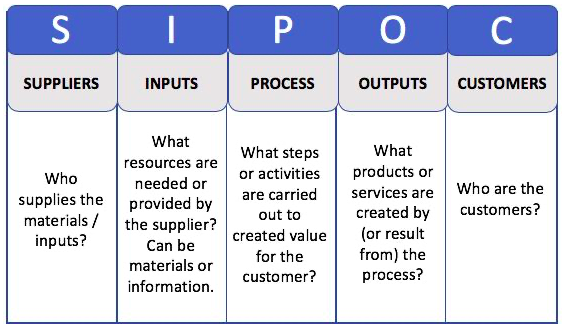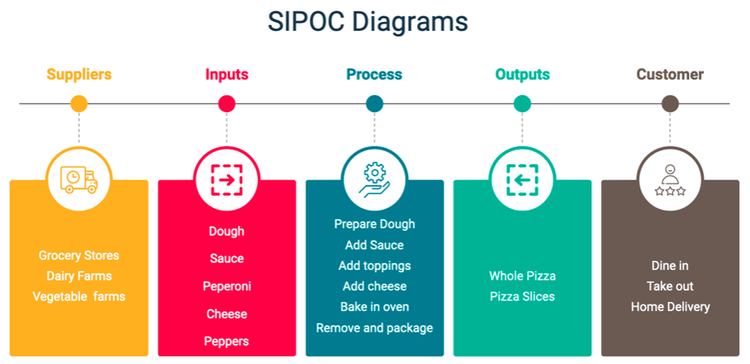Let’s face it, there’s a lot of project management techniques out there, each one a little different from the next. No business is the same, so there needs to be a variety of project management tools to meet each business’s needs.
SIPOC is a project management tool, but it works differently than others you may have used. SIPOC models are largely used in Six Sigma, a methodology for improving business processes, as well as in lean methodology and general project management efforts.
Overview: What is SIPOC in project management?
Put simply, SIPOC is an acronym for suppliers, inputs, process, outputs, and customers. In a little more detail, it is a way to determine every element of a project before work begins. It can not only help identify the elements but also pinpoint where things can be minimized or improved upon.
If you’re in the service industry, you will most likely use COPIS, which puts the customer first, since that is one of the main industry pillars. On the flip side, if you’re in the manufacturing industry, SIPOC was pretty much made for that so you’ll find yourself turning to this project management method often.
4 benefits of using the SIPOC model
Using SIPOC mapping is a great way to approach problem-solving within your business. Laying out a process in plain words and an easy-to-understand table will allow you to zero in on any missing elements, where they should be, and how you can fill in the gaps.
Here are a few more benefits.
1. Easier to understand than some other tools
Since you’re listing out every element of a process and which steps in the process each element belongs to, SIPOC makes it much easier to understand.
If you’re a visual learner, a SIPOC table can further help you understand a process since you’re seeing how it all plays out from the very start to the very end.
2. Helpful in identifying key players in the process
When you start to line up which people impact which step in the process, it can help you identify who the most important people are to the end result.
This is important because some things and people in a process must take priority when it comes to communication, time, and effort.
3. Confirms inputs and outputs match up
You don’t want any dangling inputs that don’t end up anywhere. You’d be wasting your time, effort, and money with an input that isn’t producing anything.
Since SIPOC is a tool used for lean methodology, identifying and reducing waste is a key goal.
4. Helps determine where time, money, and materials can be saved
If you’re doing a SIPOC chart in order to cut down on excess personnel or save money, knowing the key players in any given process can aid in that process. If you notice that there are more people than required involved in a certain process, that’s a good place to cut back.
It is the same with other types of resources -- mapping out a process can illuminate excess.
Example of a SIPOC diagram
There’s a lot of examples of SIPOC charts out there and they can get really confusing and complicated. The one below is a simple SIPOC example that guides you, with questions, through what should be in each column.

This simple example of a SIPOC layout asks important questions, that when answered, should guide you in completing your own SIPOC. Image source: Author
Now, let’s take a look at a SIPOC example where all of the fields are filled in. To make it simple, we will use an example for making pizza.

In this example, the process of making a pizza is explored, from the suppliers of the ingredients to who can receive the finished product. Image source: Author
How to create a SIPOC diagram for your project
The steps for creating a SIPOC diagram are kind of built-in, but you won’t be working left to right like you would expect because this isn’t a linear representation of a process. Follow the steps below for the easiest way to create a SIPOC table.
1. Create a table with five columns
Chart out your SIPOC table somewhere others have access to it to encourage collaboration. A white erase board, a chalkboard, or a smart board are all good options, as items can be erased, rewritten, or added as necessary.
Label each column with one letter in SIPOC, in that order (unless you are using COPIS).
2. List the steps of a process
It’s recommended to start with the P in SIPOC and work your way through the table after you’ve established the process. It’s also recommended to have lists of four to seven steps to keep the table from becoming too convoluted.
3. List key outputs
To the right of your process column is where you list the corresponding outputs. It makes sense to do the outputs next and work somewhat backward because it’s easier to assign inputs and suppliers when you already have the end result laid out.
4. Write out recipients of outputs or customers
Up next is the last part of SIPOC, and that’s writing out who is on the receiving end of each output. It could be the same for all outputs, or each one could have a different customer or recipient.
5. Enter the inputs
The second letter in SIPOC but the second to last step in the process is the inputs. Referring to the example above, this section is where you list all of the resources that are provided by the suppliers.
This could be ingredients, materials, or even people if that’s what your project requires.
6. List suppliers
Last but not least, it’s time to list your suppliers. These are the people or companies that provide the resources for your inputs. Make sure to list each supplier per input so you get the full picture.
Should you use SIPOC for your project management?
You might be tempted to use a SIPOC table for every process your business goes through, but there are times when using one just isn’t the best option.
Keep reading for when to use a SIPOC table and when to go with something else.
When using SIPOC makes sense
There are very clear uses for a SIPOC table. These are ones you’ll hear over and over again.
- Providing an overview: Presenting a SIPOC table to people who don’t have a base knowledge of the process will help provide an overview of the process so they can be familiar with what’s going on.
- Providing a refresher: Some projects go on endlessly or get repeated on a daily basis. It can be easy to forget the ins and outs of the process, so use a SIPOC map to jog memories.
- Reorganizing or revamping: If you’re experiencing scope creep, adjusting your SIPOC to reflect those changes and presenting that updated chart to employees will keep everyone up to date.
- Redesigning: Sometimes along the way, you realize a process just isn’t working or your organization has changed the way projects work. Using a SIPOC table is an organized way to go about a redesign.
When you should try a different project management technique
While the SIPOC tool can be beneficial in almost any industry, it’s not always the best option. If you find yourself in any of the following situations, maybe another project management process would be better.
- Rigid work environment: If you’re in a workplace that doesn’t seek out collaboration or has very strict ways things work without much room for change, using SIPOC might not be a good option. PRINCE2 is a more recommended option.
- Focused on speed: Getting things done as quickly as possible is sometimes necessary, and using a project management tool to increase the speed of delivery is beneficial. SIPOC might not be the one.
- Linear processes: It’s not that SIPOC wouldn’t work for linear processes, but it’s not the best option. Even something like a data flow diagram would work better than a SIPOC diagram.
- Tracking progress: If you’re looking for a way to track the progress of a project, a SIPOC table isn’t the best use of your time. A project tracker is more often recommended.
Summing up SIPOC
SIPOC -- suppliers, inputs, process, outputs, and customers -- is a project management tool that can be used in almost any industry for any process. While it’s not the be-all and end-all for project management, there are specific use cases for which a SIPOC makes the most sense.
You don’t need project management software in order to create a SIPOC chart, and it can be as simple or as complex as you want or as the project requires.
Our Small Business Expert
We're firm believers in the Golden Rule, which is why editorial opinions are ours alone and have not been previously reviewed, approved, or endorsed by included advertisers. The Ascent does not cover all offers on the market. Editorial content from The Ascent is separate from The Motley Fool editorial content and is created by a different analyst team.